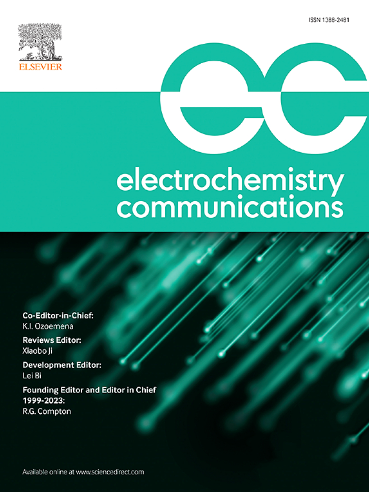Applicability of microcapillary electrochemical droplet cell for monitoring microbiologically induced corrosion
IF 4.7
3区 工程技术
Q2 ELECTROCHEMISTRY
引用次数: 0
Abstract
Formed biofilms can induce corrosion of metallic substrates through the secretion of corrosive chemical species, changes in local acidity, and the creation of galvanic oxygen concentration cells. Electrochemical testing is useful to study and monitor the growth of biofilms on metallic substrates. Macroelectrochemical testing gives an average measurement of all the chemical interactions and processes in the sampled area which is typically on the mm2 to cm2 scale. Microcapillary electrochemical droplet cell testing can perform AC and DC electrochemical measurements on the µm2 scale, allowing measurements of local electrochemical processes in the picoampere range. Adapting this technique for use in studying microbiologically induced corrosion could provide high-resolution in-situ characterization of biofilm growth. Low alloy steel coupons were subjected to macro- and microelectrochemical techniques to characterize the influence of microbiological entities on the corrosion process.
微毛细管电化学液滴池在监测微生物引起的腐蚀方面的适用性
形成的生物膜可通过分泌腐蚀性化学物质、改变局部酸度和建立电氧浓缩池等方式诱发金属基底的腐蚀。电化学测试有助于研究和监测金属基底上生物膜的生长情况。宏观电化学测试可对取样区域(通常为平方毫米至平方厘米)内的所有化学作用和过程进行平均测量。微毛细管电化学液滴池测试可在微平方米范围内进行交流和直流电化学测量,从而可以测量皮安培范围内的局部电化学过程。将这一技术用于研究微生物诱导的腐蚀可提供生物膜生长的高分辨率原位表征。对低合金钢试样进行了宏观和微观电化学技术研究,以确定微生物实体对腐蚀过程的影响。
本文章由计算机程序翻译,如有差异,请以英文原文为准。
求助全文
约1分钟内获得全文
求助全文
来源期刊

Electrochemistry Communications
工程技术-电化学
CiteScore
8.50
自引率
3.70%
发文量
160
审稿时长
1.2 months
期刊介绍:
Electrochemistry Communications is an open access journal providing fast dissemination of short communications, full communications and mini reviews covering the whole field of electrochemistry which merit urgent publication. Short communications are limited to a maximum of 20,000 characters (including spaces) while full communications and mini reviews are limited to 25,000 characters (including spaces). Supplementary information is permitted for full communications and mini reviews but not for short communications. We aim to be the fastest journal in electrochemistry for these types of papers.
 求助内容:
求助内容: 应助结果提醒方式:
应助结果提醒方式:


